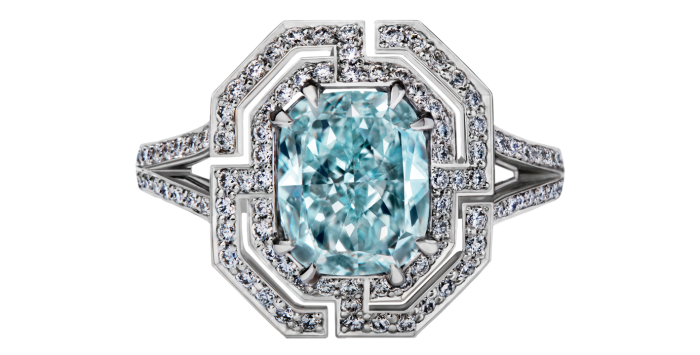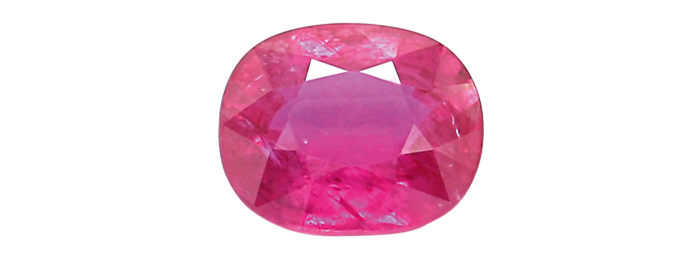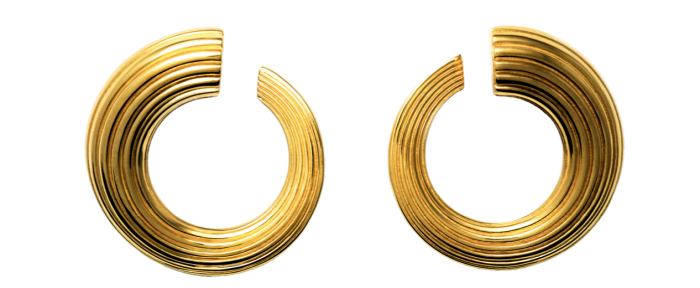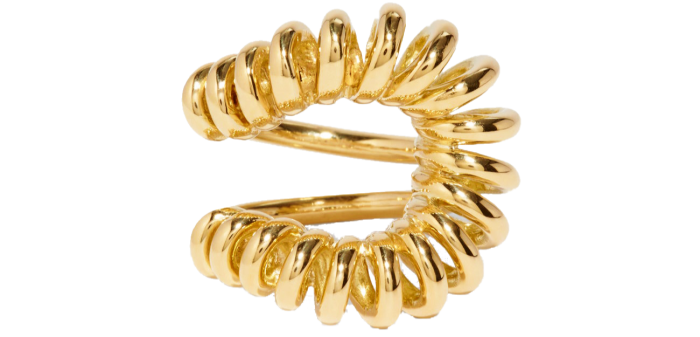
[ad_1]
Track and trace is taking on a whole new meaning in the world of gems and jewels, where transparency and traceability are central to the burning topics of ethics and sustainability. Just as routine as knowing where your olive oil or coffee beans come from, understanding the origins of gemstones – the integrity of their route from source to salon privé – is fast becoming an essential part of the jewellery-buying experience, and a way to ensure jewels come from a “good” place.
Gemstones have often had a bad reputation, not least regarding the environmental impact associated with mining and the ethical issues around sourcing from conflict zones, most notably the nefarious “blood” diamonds sold to fund civil wars in Angola and Sierra Leone. Over the past 20 years, however, this murkiness has begun to clear as the convoluted supply chain is slowly unravelled and revealed. This is not philanthropy, says Iris Van der Veken, executive director of the Responsible Jewellery Council. “Sustainability is now seen as fundamental to business strategy. Especially during the pandemic, companies have realised that a responsible business is a resilient business.”
The RJC was established in 2005, explains Van der Veken, with a clear mission to build trust in the jewellery and watch sector. “[Corporate social responsibility] wasn’t sexy,” she adds, “but there was a need to establish a standard for the industry, a holistic approach to sustainability, encompassing human rights, labour rights, labour conditions and environmental factors.” Founding companies included Tiffany & Co, Cartier, Rio Tinto and De Beers (as the Diamond Trading Company); today it has more than 1,450 members who have signed up to a code of practice and must be inspected and audited by an independent third party in order to receive and retain RJC certification.
As such, the diamond industry has engineered one of the biggest turnarounds in ethical and environmental standards – particularly in traceability – and is now among the most closely regulated of luxury sectors. In 2019, global diamond sales reached $79bn, and US diamond jewellery sales in the first quarter of this year indicate record-breaking growth, buoyed by millennial shoppers. The Kimberley Process was the first to address the issue of conflict diamonds, and today, according to Feriel Zerouki, senior vice president of corporate affairs at De Beers Group, 99.8 per cent of diamonds on the market are certified as conflict-free. Imperfect but a positive first step, the KP is now backed by a host of initiatives working towards full traceability and responsibility through the supply chain.
So how do consumers know if a diamond comes from a “good” place? Asking about membership of the RJC is a start, although the organisation is not without its criticism. Being able to see a transparent chain of production and custody is key to ethical buying. De Beers Group, which operates mines in South Africa, Canada, Namibia and Botswana, leads the way. Since 2005, it has imposed strict social, ethical and environmental standards on its own operations, as well as on companies or individuals involved in the supply route – trading, cutting, polishing, setting – which now numbers some 2,600 entities employing around 350,000 workers. De Beers even heads a pioneering project, CarbonVault, exploring the use of kimberlite (diamond-bearing) rock to absorb CO2 beyond neutrality – possibly even to the point of becoming carbon-negative.

Tiffany & Co is also a leader in pushing for sustainability standards, believing diamond traceability is the best way to ensure environmental and social responsibility. Through the Diamond Source Initiative, the LVMH-owned jeweller shares diamond provenance with customers, and since 2020, the Diamond Craft Journey has followed the entire route of a stone via laser-etched T&Co serial numbers.
As in every area of art and luxury, blockchain technology is revolutionising provenance tracing of gemstones. Four years ago, De Beers created “Tracr”, to identify and track diamonds (initially two carats and above) throughout their lifeline. The rough diamond is scanned, the cut stone re-visualised, then checked and documented at each stage of handling, building an immutable track-and-trace record. Zerouki explains: “The aim was to put down a foundational layer of trust, to answer consumer demand, and bring the diamond’s story to life.” The brand’s parallel GemFair initiative does the same for artisanal diamond mines, developing a conduit for small-scale miners and their stones, as Zerouki says, so as not to leave anyone behind.

Tracing technology has been made even more sophisticated with the revolutionary process of nano-marking. Alrosa, the Russian company with diamond mines in Yakutia, is implementing a tracking process by which a nano-mark is imprinted into the crystal structure of a rough diamond at source. Peter Karakchiev, Alrosa’s head of international relations, emphasises that this is not laser-marking, cannot be faked or polished out, and needs special equipment to be read. “Traceability is top of our minds,” he says. “But this is far more than simply knowing the origin, it is not lip service. We’re introducing tech solutions to deal with transparency issues, and we know that consumers will ask for a diamond that gave back to communities.”
As a whole, today’s diamond industry tries to counteract the mining of a finite resource through preservation of wildlife, biodiversity programmes, restoration of mined land and broader conservation. Plans for rehabilitation have to be in place even before a mine can open. Many companies bring social opportunities to the communities in which they operate mines – not only in employment but for education and skills training, hospital development and, as with Petra Diamonds, founding member of the Natural Diamond Council, stimulating and nurturing local businesses. Botswana in particular has flourished thanks to diamond mining, as the government invests proceeds from the mines back into the country and its communities. “A couple of years ago I visited Botswana to learn more about diamonds and the impact that industry has on the country,” says Livia Firth, founder and creative director of Eco-Age. “What I found there is a blueprint of how governments and businesses can partner to benefit civil society. The fashion industry should look at that and learn.” As De Beers’s Zerouki says: “Some people see a hole in the ground, we see 400 schools, hospitals, jobs, food, life skills, livelihood.”

The Karowe mine, owned by the ethically driven Lucara Diamond Corporation, focuses on providing local employment and staff training, so that today 99 per cent of the workforce is Botswanan; the managing director, Naseem Lahri, is the first woman MD of a diamond mine. Karowe also works directly, hand-in-hand, with the dynamic Antwerp-based diamond manufacturer HB Antwerp. HB’s aim is to shorten and simplify the convoluted, inefficient supply chain, removing wastage, speculation and opacity. The company has most recently been collaborating with Louis Vuitton to create bespoke cuts from two of the rarest and most spectacular rough stones recovered from the Karowe mine, the Sewelô and Sethunya, illuminating the entire trail from mine to masterpiece. “When it comes to diamonds, Louis Vuitton is very quickly moving towards vertical integration, moving closer to the mines, and the energy is incandescent,” says Louis Vuitton artistic director for watches and jewellery Francesca Amfitheatrof. “Clients are intrigued by every aspect of sourcing, and cutting, they’re eager to know more, to understand the ethics, and both traceability and education are vital.”
Raluca Anghel, head of external affairs and industry relations at Natural Diamond Council, adds: “The world of diamonds has experienced a paradigm shift, and while we have worked hard to achieve this positive transformation, currently supporting the livelihoods of 10 million people globally, there is still work to be done. We need to further strengthen communities in diamond producing countries and become even better environmental stewards. Currently 80 per cent of value created goes back to producer communities, which is something to be proud of, and with advancing widespread use of track-and-trace technology, consumers will be able to step right into their diamond’s journey and cherish the positive impact they helped drive.”
And what of the more fragmented world of coloured gem mining and trading? Colour has been the big story in high jewellery for more than a decade, but coloured gems cannot be quantified, classified or commoditised in the same way as diamonds: whereas only 15 per cent of diamond mining is artisanal, 80 per cent of coloured gemstone mining is small-scale artisanal, involving some 30 million miners – and making formalising the industry very tricky indeed. Gemfields, the mining company and leading supplier of African coloured gems, principally Zambian emeralds and Mozambican rubies, was instrumental in putting coloured gems on the map, says Joanna Hardy, independent fine jewellery specialist and author of Ruby: The King of Gems and Sapphire: A Celebration of Color, among others. Now origins can be tracked through two innovative blockchain platforms launched by Gübelin Gem Lab, the Swiss gem-testing laboratory, in collaboration with Everledger: Provenance Proof, the first digital ledger for coloured stones, and the Emerald Paternity Test. Since its launch in 2019, Provenance Proof Blockchain has processed more than 500,000 coloured gems, detailing the entire transformation process from rough to finished jewel, capturing data that includes unique characteristics, origin, mine and its ethical and sustainability credentials, any treatment and colour enhancement, cut and setting. The platform allows everyone involved – cutter, merchant or jeweller – to be identified, and the document can be accessed by the jewel owner. The Emerald Paternity Test uses the same mix of nanotechnology and DNA engineering. Raphael Gübelin, CEO of the Lucerne-based gem laboratory, says: “Every stakeholder has to take responsibility and prove their engagement in transparency. No one can hide any more.”

Increasingly jewellers, especially individual designers, are seeing the value in collaborating directly with mines that are committed to responsible, ethical and sustainable practice. Ming Lampson is one such independent designer, with a special passion for sapphires in all colours. She works hard to ensure traceability and ethical practices, she says, and asks every one of her suppliers about the source and route taken to get to her. “I try to buy from cutters who own the mines, but however good your intent, the route is not always clear and transparent. My dealers know they have to be honest about what they know or don’t know, and prevent ‘greenwashing’.”
Boodles has formed an alliance with Petra Diamonds, owners of the celebrated Cullinan mine in South Africa, the source of rare blue diamonds and of the largest-ever historic rough diamond, which produced stones now in the British Crown Jewels. Annoushka Ducas of Annoushka has created a striking capsule collection set with superb specimens from Fuli Gemstones, the company behind the newly discovered peridot mine in China, the largest of its kind. The Yiqisong Nanshan mining project intends to bring employment and economic development to the rural community. Even more, Fuli is exploring ways of utilising the byproducts of peridot mining – sands and basalt – for industrial purposes, while research has found that olivine sand can help de-acidify the oceans. Ducas, who says she was delighted to have “full visibility on the whole process”, set the octagon-cut peridots in colour-drenched frames of malachite and pink sapphires, ensuring the jewels are transformable for versatility.

Likewise, Italian brand Pomellato is working with Greenland Ruby, which is mining a recently discovered deposit of vibrant rubies and pink sapphires located in Aappalutoq, a remote, icy, mountainous region of south-west Greenland. Ranging from pink “pigeon blood” through frosty pink to moody grey, purple and blue, the stones are believed to be the oldest rubies on earth, formed some three billion years ago, and claimed as the most responsibly sourced gemstones of their kind in the world today. Each rough is numbered and registered, along with the stones it yields, building a fully traceable family tree.
In Brazil, designer-jeweller Ara Vartanian was inspired to create his Conscious Mining collection when he visited three small-scale Brazilian mines: Cruzeiro for rubellites; Belmont for emeralds; and Brazil Paraíba for blue tourmalines. Vartanian saw firsthand how these mines are run, how impassioned their owners are about the gems, and how invested they are in the wellbeing of their workers – even growing fruit and vegetables on site for their meals. “Our path forward is a work in progress,” he says. “But we know that path follows respect for cultures, protection of the environment, support for local economic development of these communities, defence of historical social issues in our country and, above all, the need to overcome the effects of our individual actions.”

Finally, for anyone wanting to get closer to the “good” that the gem trade can bring, look to Moyo Gems; a collaboration between the Tanzania Women Miners Association and Pact, a non-profit organisation set up in 2018 to help marginalised communities in the Umba Valley in Tanzania. According to Cristina Villegas, Pact’s director of Mines to Markets, one-third of all miners in the world are women, and as small-scale artisanal mines are less mechanised and more labour-intensive, women play a vital role in the workforce. Yet they have often been exploited, says Villegas, adding that women miners often know least about the stones they recovered. Moyo Gems has instigated literacy programmes, gemological training, health and safety education, and are improving working conditions with grants from the Tiffany & Co Foundation, the Gemological Institute of America, and the World Bank EGPS Fund.
Most importantly, Moyo Gems arranges four market days a year where women trek from their villages, bringing their gems, rubies, sapphires, tourmalines, garnets, citrines and amethysts to be sorted by trustworthy local dealers and then presented for sale at fair market prices to a select group of international traders, including Maison Piat, Nineteen84 and Anza Gems. These traders in turn sell the gems to jewellers around the world, or online directly to private clients, and the gems are blockchain tracked. The results are tangible and impressive; female miners now earn three to 10 times more than they previously have. As Villegas says: “Each woman is looking for that one stone that will change her life.”
Projects such as Moyo Gems are slowly changing the narrative around gemstones. All players admit there is a long way to go to build trust in the gemstone world. But these initiatives, along with industry leaders, are beginning the long overdue process that will hopefully change perception and bring openness to the industry. As Ara Vartanian says: “We are just getting started, because for us the future is now and it can and should be bright for everyone.”
Gold stars
The supply chain for precious metals is notoriously opaque. Jessica Beresford finds the brands who go above and beyond to make sure they’re not tarnished








[ad_2]
Source_link